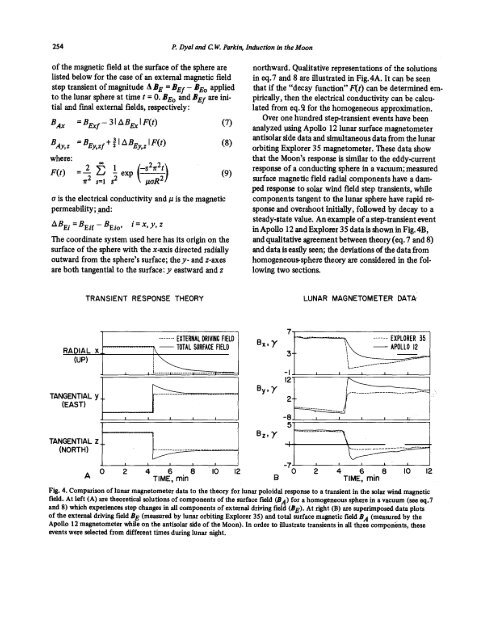global electromagnetic induction in the moon and planets - MTNet
global electromagnetic induction in the moon and planets - MTNet
global electromagnetic induction in the moon and planets - MTNet
Create successful ePaper yourself
Turn your PDF publications into a flip-book with our unique Google optimized e-Paper software.
254 P. Dyal <strong>and</strong> C. W. Park<strong>in</strong>, Induction <strong>in</strong> <strong>the</strong> Moon<br />
of <strong>the</strong> magnetic field at <strong>the</strong> surface of <strong>the</strong> sphere are northward. Qualitative representations of <strong>the</strong> solutions<br />
listed below for <strong>the</strong> case of an extemal magnetic field<br />
8E =<br />
step transient of magnitude A<br />
BEf — BEO applied<br />
to <strong>the</strong> lunar sphere at time t = 0. BEO <strong>and</strong> BE! are mi<strong>in</strong><br />
eq.7 <strong>and</strong> 8 are illustrated <strong>in</strong> Fig. 4A. It can be seen<br />
that if <strong>the</strong> “decay function”F(t) can be determ<strong>in</strong>ed em-<br />
pirically, <strong>the</strong>n <strong>the</strong> electrical conductivity can be calcutial<br />
<strong>and</strong> fmal external fields, respectively: lated from eq.~ for <strong>the</strong> homogeneous approximation.<br />
B = B — 31 I.~B I F(t) (7~ Over one hundred step-transient events have been<br />
Ax Exf Ex / analyzed ~is<strong>in</strong>gApollo 12 lunar surface magnetometer<br />
B = B + ~ I ~B IF(~ ‘8’ antisolar side data <strong>and</strong> simultaneousdata from <strong>the</strong> lunar<br />
Ay,z Ey,zf 2 Ey,z ‘‘ “ / orbit<strong>in</strong>g Explorer 35 magnetometer. These data show<br />
where: that <strong>the</strong> Moon’s response is similar to <strong>the</strong> eddy-current<br />
F’t’ = 2 1 (—s2lr2t\ (9\ response of a conduct<strong>in</strong>g sphere <strong>in</strong> a vacuum; measured<br />
‘‘ ~2 s1 ~2 exp ~ R21 “ ‘ surface magnetic field radial components have a damped<br />
response to solar w<strong>in</strong>d field step transients, while<br />
a is <strong>the</strong> electrical conductivity <strong>and</strong> p is <strong>the</strong> magnetic components tangent to <strong>the</strong> lunar sphere have rapid repermeability;<br />
<strong>and</strong>: sponse <strong>and</strong> overshoot <strong>in</strong>itially, followed by decay to a<br />
- steady-state value. An exampleof a step-transientevent<br />
AB.=B.—B. z=xyz -<br />
Ei Eif Ezo’ mApollo l2<strong>and</strong>Explorer35dataisshownmFig.4B,<br />
The coord<strong>in</strong>ate system used here has its orig<strong>in</strong> on <strong>the</strong> <strong>and</strong> qualitative agreement between <strong>the</strong>ory (eq. 7 <strong>and</strong> 8)<br />
surface of <strong>the</strong> sphere with<strong>the</strong> x..axis directed radially <strong>and</strong> data is easily seen; <strong>the</strong> deviations of <strong>the</strong> data from<br />
outward from <strong>the</strong> sphere’s surface; <strong>the</strong>y- <strong>and</strong> z-axes homogeneous-sphere<strong>the</strong>ory are considered <strong>in</strong> <strong>the</strong> fol-.<br />
are both tangential to <strong>the</strong> surface: y eastward <strong>and</strong> z low<strong>in</strong>g two sections.<br />
TRANSIENT RESPONSE THEORY LUNAR MAGNETOMETER DATA<br />
EXTERNAL DRIVING FIELD B -- EXPLORER 35<br />
RA~ALXL \çIOIALSUREELD X~ O~12<br />
TANGENTIALY B~Y<br />
~ Bz,Y ~2468 10 12<br />
A TIME, miii B TIME, mm<br />
Fig. 4. Comparison of lunar magnetometer datato <strong>the</strong> <strong>the</strong>ory for lunar poloidal response to a transient<strong>in</strong> <strong>the</strong>solar w<strong>in</strong>d magnetic<br />
field. At left (A) are<strong>the</strong>oretical solutions ofcomponents of <strong>the</strong> surfacefield (B<br />
4) for a homogeneous sphere <strong>in</strong> a vacuum (see eq.7<br />
<strong>and</strong> 8) which experiences step 8E changes (measured <strong>in</strong> all bycomponents lunar orbit<strong>in</strong>g of external Explorerdriv<strong>in</strong>g 35) <strong>and</strong>field total (BE). surfacemagnetic At right (B) are field superimposed B dataplots<br />
of <strong>the</strong>external driv<strong>in</strong>g field<br />
4 (measured by <strong>the</strong><br />
Apollo 12 magnetometer while on <strong>the</strong> antisolar side of <strong>the</strong> Moon). In orderto illustrate transients <strong>in</strong> all three componimts, <strong>the</strong>se<br />
events were selected from different times dur<strong>in</strong>g lunar night.

















